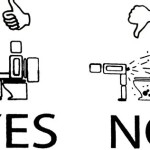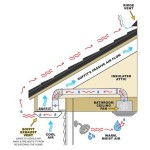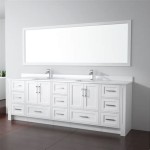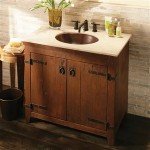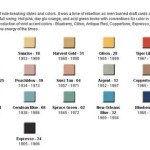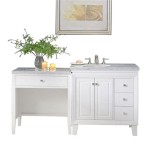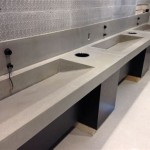Bathroom Cabinets Under Sink: Maximizing Storage and Organization
The bathroom, often a space of limited square footage, presents a challenge for effective storage. One of the most underutilized areas is the space underneath the sink. Bathroom cabinets designed for under-sink storage offer a practical solution, transforming this often-cluttered zone into an organized and functional area. These cabinets not only conceal plumbing but also provide valuable storage for toiletries, cleaning supplies, and other bathroom essentials, contributing to a cleaner, more streamlined bathroom environment.
Selecting the right under-sink bathroom cabinet requires careful consideration of several factors, including dimensions, style, material, and the specific storage needs of the user. A well-chosen cabinet can significantly enhance the overall aesthetic of the bathroom while simultaneously improving its functionality. This article will delve into the various aspects of under-sink bathroom cabinets, offering guidance on how to choose the ideal option for any bathroom space.
Understanding Under-Sink Cabinet Dimensions and Compatibility
The first, and arguably most crucial, step in selecting an under-sink cabinet is accurately measuring the available space. This involves measuring the width, depth, and height of the area under the sink, taking into account any obstructions such as pipes and shut-off valves. Failure to account for these elements can result in purchasing a cabinet that does not fit or requires extensive modifications. It is prudent to create a detailed sketch of the under-sink area, noting the exact placement of plumbing fixtures, to ensure compatibility with the chosen cabinet.
Standard under-sink cabinet sizes vary, but typically range from 24 to 48 inches in width, 16 to 24 inches in depth, and 30 to 36 inches in height. However, custom-built cabinets can be tailored to fit unique spaces or accommodate specific plumbing configurations. When selecting a cabinet, ensure that the back panel has pre-cut openings or can be easily modified to allow for plumbing access. Some cabinets feature adjustable shelves or drawers, providing further flexibility in organizing stored items.
Beyond the exterior dimensions, consider the internal storage space offered by the cabinet. A cabinet with multiple shelves or drawers will provide greater organizational capabilities than a simple open-shelved unit. Also, consider the weight capacity of the shelves, especially if planning to store heavy items such as large bottles of shampoo or cleaning supplies.
Floating under-sink cabinets, which are mounted to the wall rather than resting on the floor, are an increasingly popular option. These cabinets create a sense of spaciousness and facilitate easier cleaning underneath. However, installation requires careful consideration of wall strength and the use of appropriate mounting hardware to ensure stability and safety.
Exploring Materials and Styles for Under-Sink Cabinets
The material of an under-sink cabinet plays a significant role in its durability, aesthetics, and resistance to moisture. Bathrooms are inherently humid environments, making moisture resistance a critical factor in material selection. Common materials used for under-sink cabinets include solid wood, plywood, MDF (Medium-Density Fiberboard), and PVC (Polyvinyl Chloride).
Solid wood cabinets offer a classic and elegant aesthetic, but they are generally more expensive and require proper sealing to prevent moisture damage. Plywood is a more affordable alternative to solid wood, offering good strength and resistance to warping. MDF is a cost-effective option that is less susceptible to warping than solid wood but may be more vulnerable to moisture damage if not properly sealed.
PVC cabinets are entirely waterproof and resistant to mold and mildew, making them an ideal choice for humid bathroom environments. However, PVC cabinets may not offer the same aesthetic appeal as wood or wood-based materials. The choice of material should be based on a balance of cost, aesthetics, and durability considering the specific bathroom environment. The finishing of the cabinet also is important. A good quality paint or sealant is crucial to prevent moisture damage and longevity.
The style of the under-sink cabinet should complement the overall design of the bathroom. Cabinets are available in a wide range of styles, from traditional to modern, minimalist to ornate. Traditional cabinets often feature raised panel doors, decorative hardware, and intricate detailing. Modern cabinets tend to have clean lines, simple hardware, and a minimalist aesthetic.
Consider the color and finish of the cabinet to ensure it coordinates with the existing bathroom fixtures and décor. White and neutral-colored cabinets are popular choices, as they create a bright and airy feel. Darker colored cabinets can add a touch of sophistication and drama to the bathroom. The hardware, such as knobs and pulls, should also be chosen to complement the overall style of the cabinet and the bathroom.
Open shelving can be incorporated into under-sink cabinets to provide easy access to frequently used items. Baskets and bins can be used to organize items on open shelves, creating a visually appealing and functional storage solution. The combination of closed cabinet space and open shelving can create a balanced and versatile storage solution.
Optimizing Organization and Functionality Within the Cabinet
The internal organization of an under-sink cabinet is crucial for maximizing its functionality. Simple shelves can work, but optimized options include things like pull-out drawers, adjustable shelves, and specialized organizers. Pull-out drawers offer easy access to items stored at the back of the cabinet, preventing the need to rummage through piles of toiletries. Adjustable shelves allow for customization of the storage space to accommodate items of varying sizes.
Consider incorporating specialized organizers to maximize the use of space and keep items neatly arranged. Organizers specifically designed for storing hair styling tools, such as hair dryers and curling irons, can help prevent clutter and keep these items readily accessible. Drawer dividers can be used to separate and organize smaller items, such as makeup, cotton balls, and Q-tips.
Using clear storage containers is an excellent way to organize and easily identify stored items. Clear containers allow for quick visual inspection of the contents, eliminating the need to open multiple containers to find a specific item. Labeling the containers with the contents further enhances organization and efficiency.
Pipe cut-outs in cabinets should be sealed to prevent moisture damage. Consider using flexible, self-adhesive pipe collars to create a tight seal around the pipes. These collars prevent moisture from seeping into the cabinet and causing damage to the wood or MDF.
Consider using door-mounted organizers to maximize storage space on the inside of the cabinet door. Door-mounted organizers can be used to store small items, such as cleaning supplies, sponges, and brushes. These organizers keep these items readily accessible and prevent them from cluttering the main storage area of the cabinet.
Regularly declutter and reorganize the under-sink cabinet to prevent buildup of unnecessary items. Discard expired or unused products to free up space. Periodically clean the cabinet to prevent the buildup of dust and grime. Maintaining a clean and organized under-sink cabinet will contribute to a more functional and aesthetically pleasing bathroom environment.
Installing lighting inside the under-sink cabinet can improve visibility and make it easier to find stored items. Battery-operated LED lights are a convenient and cost-effective option for adding lighting to under-sink cabinets. These lights can be easily installed and provide ample illumination for even the darkest corners of the cabinet.
Consider the use of non-slip mats or liners on the shelves of the under-sink cabinet to prevent items from sliding around. Non-slip mats provide a stable surface for stored items, preventing them from tipping over or sliding off the shelves. These mats also protect the shelves from spills and stains.
Ultimately, selecting and organizing an under-sink bathroom cabinet involves careful planning and consideration of individual needs and preferences. By taking the time to measure the space, choose the right materials and style, and optimize the internal organization, it is possible to transform this often-overlooked area into a functional and aesthetically pleasing storage solution. This investment will contribute to a cleaner, more organized, and more enjoyable bathroom experience.

Kleankin Pedestal Sink Storage Cabinet Bathroom Under With 2 Doors And Open Shelf Vanity Grey 834 431gy

Bathroom Under Sink Starter Kit The Container

Kleankin Modern Farmhouse Bathroom Sink Cabinet Pedestal Storage With Double Doors And Shelves White

My Favorite Way To Organize Cabinets Under The Bathroom Sink Homes I Have Made

Diy Pull Out Under The Bathroom Sink Storage Hamilton Park Home Inspiration For Garden

The Perfect Under Sink Organization Solution Thrifty Decor Diy And Organizing

Creative Bathroom Storage Ideas Efficient Effective

Under Bathroom Sink Organization Ideas For Small Powder Room Cabinets Blue I Style

Bathroom Storage Organizer 2 Pack Clear Under Sink Organizers Vanity Counter Container Medicine Cabinet Drawers Bins Pull Out Organization

Iheart Organizing Doubling Up On Under The Sink Storage Space
Related Posts

